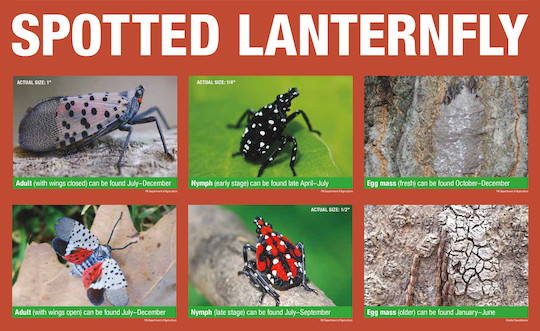The spotted lanternfly is an invasive insect that has spread throughout Pennsylvania since its discovery in Berks County in 2014. It feeds on the plant sap of many different plants, including grapevines, maples, black walnut, and other important plants in Pennsylvania.

With the growing infestation of the spotted lanternfly, people are looking for ways to do battle with the multicolored invaders. According to Jim Murphy, owner of Tri-County Pest Control, it's important for property owners to "do something," but those methods are temporary at best. There are two important things that only a pest control expert can do.
Ideally, Murphy said, is to locate the Ailanthus Tree, more commonly known as the tree of heaven. As Murphy explains it, the tree was imported from China about 100 years ago. It provides a natural habitat for the lanternfly, though the insect didn't come into the United States until 2014. Insect eggs came in on a pallet of ornamental stone, also from China.
Ideally, he said, the first thing to do is find that tree somewhere nearby and treat that against the lanternfly.
"The state Department of Agriculture also advises to find the group of the trees, and kill all but one, then treat that remaining tree," Murphy said.
But that treatment needs to be done in the spring as the eggs are hatching.
Using insecticides will work, he said, but professionals need to take care. They're not permitted to spray in a way that the insecticide goes to other properties and they need to make sure that pollinating insects are protected.
Taping a tree so that the insects get stuck on the tape and die only takes care of the currently active lanternflies.
"There won't be any residual effect. The sheer numbers make mechanical means ineffective in the long run," he said.
Again, though, he stressed it's important to "do something."
Here's a simple home defense method, courtesy of Chadds Ford Township Manager Maryann Furlong. It's safe for pets and kids, and Murphy said it would work to kill the active insects by blocking their ability to breathe.
What you'll need:
1 cup dish soap
1 cup water
Spray bottle
How to make it:
Combine the dish soap and water together into a spray bottle.
Swirl gently until they mix together.
How to use it:
You can spray this mixture directly onto lanternflies to kill them. The sticky mixture will easily drown them in soap and you even use this DIY pesticide on lanternfly eggs. Of course, you should always scrape off the eggs after you spray them just to be sure.
If you decide to go around spraying this stuff all over the bugs, be sure to clean up the dead lanternflies from your home or tree. If you don't, they'll leave behind the black honeydew mold afterward which can ruin your home.
You can mist the solution all over your trees, plants, shrubs, or anywhere else you suspect them to be. They'll be killed nearly instantly by this powerful mixture.
About Rich Schwartzman
Rich Schwartzman has been reporting on events in the greater Chadds Ford area since September 2001 when he became the founding editor of The Chadds Ford Post. In April 2009 he became managing editor of ChaddsFordLive. He is also an award-winning photographer.


 (5 votes, average: 4.40 out of 5)
(5 votes, average: 4.40 out of 5)
Comments